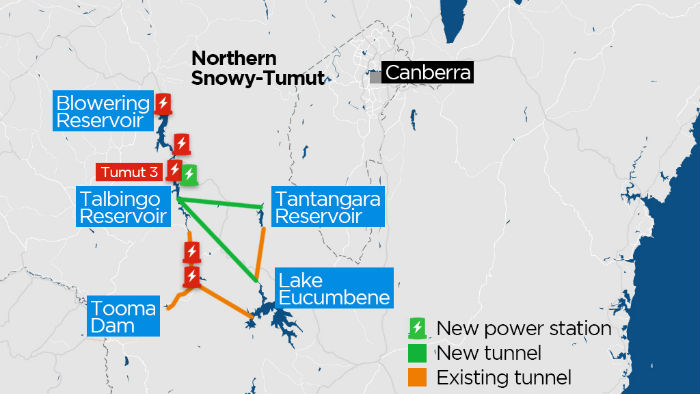You can make this stuff up, apparently:
The ABC has more on whether or not it’s a good idea:
Engineering experts are less critical than the South Australian Premier but some are warning that the expansion of the hydro-electric scheme won’t be a “magical” solution to Australia’s power problems.
And they point out that it is an old idea that has previously been ruled out as too expensive.
It is called “Pumped Hydro” — and this is how it works.
When demand for power is low, and excess supplies are available, water is pumped from one reservoir to another sitting at a higher altitude.
Then when power is in critical demand that water is released to run downhill again, passing through a generator to create electricity.
It is a well-established technology — a clean, green and renewable source of power that has been in use in Australia for a century.
And the plan to expand the Sydney Hydro Scheme isn’t new either — it was put on the drawing board back in the 1980 and rejected again, because of the price-tag attached.
But now the old plan has been picked up and dusted off, in the process blindsiding many stakeholders and prompting experts to flood the airwaves to speculate about what shape it might take.
Max Talbot, the former executive officer of Strategic Engineering at the Snowy Hydro Scheme, told ABC Local Radio previous expansion plans had proved too expensive.
“We did look at that prospect briefly, expanding the scheme goes back nearly 20 years ago,” he said.
“If he’s [Malcolm Turnbull] talking about what I think he’s talking about, then that was considered a feasible but far too expensive at the time.
Andrew Blakers, professor of engineering at the Australian National University, said if built underground the plan would not disturb the surrounding national park.
“One obvious possibility in the Snowy Mountains is to use the massive volume of water in the Eucumbene, which is the main storage reservoir for the Snowy Mountains Scheme,” he said.
“That would require about 30 kilometres or so of tunnelling and there’s a 600-metre height difference between Eucumbene and Talbingo reservoir.
“And so if you build a large underground power station with a pump and a turbine, or several, then you have effectively a giant battery without disturbing the Kosciusko National Park, because the high voltage power lines that you would need, you’d need more of them to go out to the outside world without going across the Snowy Mountains.
“And if the tunnel and power stations are underground then once again you’re not disturbing the pristine Kosciusko National Park.”
But with the details of the plan yet to be resolved, energy experts are inclined to reserve judgement on whether the plan is the answer to Australia’s looming power shortage.
The Grattan Institute’s Tony Wood said the project faced so many stumbling blocks and was unlikely to be a “magical panacea”.
“The real question here is the economics,” Mr Wood said.
“And whether it’s privately owned or publicly owned, is this a good use of public funds? That’s going to be the trick for the feasibility of the study to determine.
“And that would also be therefore the reason why no-one has leapt into this before.
“To be fair some of the really sharp issues only started to crystallise in the last six months or so, particularly for example with the announced shut down of the Hazelwood power station.”
That is echoed by another energy economist — Danny Price from Frontier Economics.
As he told RN Breakfast, he is sceptical about the plan’s viability, especially given the shared ownership of the scheme, split between the Commonwealth, Victorian and New South Wales governments.
“I’ve worked on the Snowy Hydro corporation over many years, and let me say getting anything done in the Snowy is extremely difficult as it involves the three governments that own it,” he said.
“So at this stage I would regard the Snowy proposal as a thought bubble, and it’s a bit like saying ‘I’m about to begin building a boat and rescue someone’ — it will be years off before anything happens.”
Collaboration between the Commonwealth and the two states that share ownership of the scheme is already off to a shaky start — with the Victorian Energy Minister Lily D’ambrosio telling RN Breakfast they were yet to be consulted about the project.
“The news is what we heard on the radio frankly and what we woke up to this morning,” Ms D’ambrosio said.
“So this is the way that the Prime Minister is leading this country; when he comes up with ideas, [he] doesn’t think them through, has no dialogue with the direct shareholders — NSW Government, Victorian Government — to work cooperatively on this issue.”
Victorian Premier Daniel Andrews has now been briefed on the plan, and has welcomed the Federal Government’s initiative.
And make no mistake there are plenty of stakeholders and other interested parties out there who think the plan is a great idea.
Dr Jamie Pittock is an environmental scientist with the Australian National University — and a member of the Wentworth Group of Concerned Scientists.
He is willing to give the concept conditional support because while hydro-electricity might be a clean, green and renewable technology, there is still concern about the impact the expansion plans could have on the surrounding region.
“It is somewhat ironic that climate change and renewable energy sceptics who have said that solar power and wind power can’t be used for baseline energy supply, are now embracing this off-the-shelf bulk standard technology in pumped hydro, which enables wind and solar power to supply our basic energy needs,” Dr Pittock said.
“So this is good. There are concerns about the location of the scheme, the Snowy Mountains is one of the most fragile alpine environments in Australia.
“So the detail of how those environmental impacts are managed are important.”


